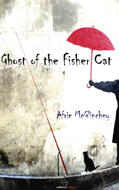 Afric McGlinchey
Afric McGlinchey
Ghost of the Fisher Cat
Salmon Poetry
ISBN: 978-1-910669-39-6
Reviewer: Maria Rouphail
What do violin strings, the mystery of Malaysian Airlines Flight 370, and poisoned quinces have in common? They are conceits in Irish poet, Afric McGlinchey’s second collection, Ghost of the Fisher Cat. Prompted by a Parisian legend of a ghost cat and its sinister human companion, McGlinchey riffs on luck, doom, and the uncanny, “familiars” which people the world over have perennially foisted onto felis domesticus, especially if its coat is black.
After all, black cats are preternatural, magical beings. McGlinchey’s chat noir, a shapeshifter par excellence, is no exception. His legendary prowess at capturing fish from the Seine engenders suspicion in a neighborhood gang that both cat and master, the alchemist Dom Perlet, are one and the same Devil incarnate. The boys drown the cat, and Dom Perlet disappears. To everyone’s horror, cat and master later return, albeit in different form.
For McGlinchey the fisher cat serves as a complex signifier, a projection of the many states of human desire in all their manifest ambiguities. Of course, the reader intuits this connection immediately. But McGlinchey gives outright expression to the motif in the eponymous poem, “Ghost of the Fisher Cat” (and here the cat, like the poet, is female):
How do [sic] describe the topography
of the imagination?
Let’s start with that fish,
lying in the gutter,
brought up from the river, or myth.
…
…twilight need offer nothing
more than the power
of imagination — this trophy
from a ghost cat’s watery skirmishes…
Obeying a law of its nature, the cat hunts to live. So, too, the “sinuous,” cat-like artist who “fishes” in the murky waters of the unconscious for the “fauna” of creative sustenance, and this
…requires a certain leap of your own
to jump out of one world
and into another.
“Cat Music,” another strong poem, describes converting animal intestines into catgut for stringed musical instruments. Production commences with “A drownling…lifted from a rain barrel.” That fact, and the poem’s title echo the urban myth of the fisher cat maliciously killed in water.
“Cat Music” establishes the inexorable work of the abattoir in the first six of ten deftly enjambed couplets, with the final step of catgut-making looped into the seventh. There is stripping, cutting, scraping. Mesenteric fat and filth washed away, the intestine is treated
through sulfuric fumes;
rolled into elongated
strings; attached
to an instrument…
When played with a bow, the transformed material produces “music so intricate / and astonishing” as to bring the cat back in new form. Music is now a sublimation of the (cat) body.
Despite the factual inaccuracy—catgut originates mostly from sheep or goat intestines—“Cat Music” establishes the paradox of life and death as a form of repurposing leading to transcendence. It is also an ars poetica, much like “Ghost of the Fisher Cat.”
The 2014 disappearance of Malaysia Airlines Flight 370 without corpse or cause goes to what is most terrifying: the possibility of our exiting the world without a trace. In “Flight MH370,” McGlinchey’s “you-are-there” approach puts the reader into an omniscient position as the plane “hastens / into radar silence.” We move among the passengers who contend with “exploding” thoughts. One man “takes the hand of a stranger.” He does so to “keep him feeling / alive, until the last moment.”
A problem exists with this logic, however. No one can say for sure what happened on that fated flight. But “hasten[ing] into radar silence” is not something the passengers could have known about, much less felt. There is no reason to assume that as the plane began to veer fatally off course—especially in the dead of night over the dark sea—anyone would have been aware of the danger. McGlinchey relies on our knowing the outcome, an assumption that undercuts the poem. More melodrama than compelling mystery, the poem misses an opportunity to get at the existential heart of the event.
One noteworthy poem is “The Glass Delusion.” Its allusion to a work by Cervantes—assuming it is deliberate—is conceptually clever. Among the Spanish writer’s dozen or so short novelas ejemplares (1613), “The Glass Graduate” (“El Licenciado Vidriera”) stands out as particularly enigmatic.
Cervantes’s story centers on young Tomás Rodaja, who climbs from impoverished obscurity to nearly the pinnacle of academic fame. His ambition is thwarted when he unknowingly eats a poisoned quince offered as an aphrodisiac by a woman seeking to seduce him. Tomás’s mind immediately descends into raving lunacy. First, he believes himself to be made entirely of glass. To avoid breaking, he effectively removes himself from community. As well, the prudential scholar has disappeared, and is replaced by a malcontent who dispenses caustic admonitions to all comers. What the glass man utters is frequently wrong and outrageous. He is flat out crazy and must be stopped. An “alchemist” monk restores Tomás to his former lucidity, at which point the young man can no longer access the “glass” alter ego engendered by the poisoned quince.
McGlinchey’s self-absorbed “glass man” revises this character and his predicament. The poem begins with personal history:
When I was a boy, I told my mother
about strange things that I dreamt.
Translucent wings leaping from my shoulders.
When his mother responds that her son is therefore an artist, a great “fire bellow[s]” into him. He then begins to see even stranger things:
crystal snakes, goblets,
colossal rainbow globes.
A chance encounter with a woman who feeds him a doctored quince initiates him sexually, and it goes badly. From then on, the artist is “locked” in a mirror, his heart a “bird of glass / thud[ding] its frantic wings against [his] chest.” He fears “breaking into smithereens,” and he must paint with his body “encased in iron ribs, for protection.” His self-consciousness is unbearable as “eyes…gaze / so freely at my every wheeling thought.” And worse, he fears to have become, like a clear glass pane, invisible.
What to make of the plight of McGlinchey’s speaker? Returning to Cervantes, two points should be made. First, the “glass man” was a noted psychiatric phenomenon in the early modern period, as McGlinchey indicates. Second, Tomás’s debilitation occurs through extreme self-absorption—a significant moral failing in the Spanish Baroque, which presumed a reciprocity between the private self and the community. They must harmonize for the well-being of both.
In “The Glass Delusion,” no corrective reciprocity occurs, no transformation, or “leap…out of one world and into another.” There is only an intensification of an original malady in the artist’s collapsed inner world. Without the resources of community and shared myth, the speaker falls into deeper existential isolation. Can McGlinchey be describing a contemporary predicament? Perhaps she is.

